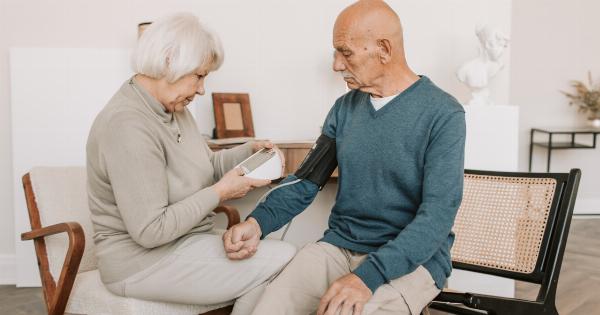Hypotension, commonly known as low blood pressure, is a condition characterized by abnormally low readings on the blood pressure chart.
While most people consider high blood pressure a more significant health concern, hypotension can also have a range of adverse effects on the body. In this article, we will explore the physical indications of hypotension, including its symptoms, causes, and management strategies.
Common Symptoms of Hypotension
Hypotension often presents various symptoms that can significantly impact an individual’s daily life. These symptoms may manifest differently in each person, but some of the most commonly experienced physical indications of hypotension include:.
1. Dizziness and Lightheadedness
One of the most prevalent symptoms of hypotension is dizziness or lightheadedness. Low blood pressure can lead to inadequate blood flow to the brain, resulting in feelings of unsteadiness, wooziness, or faintness.
Individuals with hypotension may experience frequent episodes of dizziness, especially when standing up quickly or after prolonged periods of rest.
2. Fatigue and Weakness
Low blood pressure can cause reduced blood flow to the muscles and tissues, which can lead to feelings of fatigue and weakness. Individuals with hypotension may often feel tired or lack energy, even after getting adequate rest.
These sensations of weakness can significantly impact one’s ability to perform daily activities and may lead to decreased productivity.
3. Blurred Vision
Inadequate blood supply to the eyes due to hypotension can result in temporary blurred vision or difficulty focusing on objects. Blurriness may affect one or both eyes and can occur intermittently.
Individuals experiencing these visual disturbances should consult a healthcare professional to determine if hypotension is the underlying cause.
4. Nausea and Fainting
In severe cases, hypotension may cause individuals to experience nausea or even fainting spells. A sudden drop in blood pressure can limit the oxygen and nutrient supply to the brain, leading to a feeling of nausea or loss of consciousness.
Fainting episodes can be alarming and have the potential for injury, so it is essential to seek medical attention if you experience such symptoms.
5. Cold and Clammy Skin
Hypotension can lead to poor circulation, which may result in cold and clammy skin. The reduced blood flow can prevent adequate heat distribution, leaving the skin feeling cold and damp to the touch.
This symptom is particularly noticeable in the extremities, such as the hands and feet.
6. Rapid or Shallow Breathing
In some cases, hypotension can manifest as rapid or shallow breathing. Reduced blood flow to the lungs can affect the oxygen exchange process, leading to increased breathing rates or shallow breaths.
If you notice any abnormal changes in your breathing patterns, it is crucial to consult a healthcare professional for proper evaluation.
7. Rapid Heartbeat (Tachycardia)
While hypotension is associated with low blood pressure, it can paradoxically cause a rapid heartbeat in some individuals. To compensate for the decreased blood flow, the heart may pump faster to maintain an adequate supply to vital organs.
This increase in heart rate, known as tachycardia, is often accompanied by other symptoms like dizziness or shortness of breath.
8. Difficulty Concentrating
Due to the reduced blood flow to the brain, individuals with hypotension may experience difficulty concentrating or maintaining focus. This cognitive symptom can impact daily tasks, work productivity, and overall quality of life.
Managing hypotension effectively can help alleviate these concentration difficulties and improve mental clarity.
9. Pressure Sensitivity
Hypotension may sometimes cause individuals to become more sensitive to pressure changes. For example, sudden positional changes, such as standing up from a seated position, can trigger symptoms like dizziness, lightheadedness, or even fainting.
Monitoring blood pressure and taking precautions when changing positions can help reduce the impact of pressure sensitivity.
10. Exercise Intolerance
Exercise intolerance is a common physical indication of hypotension.
Individuals with low blood pressure may find it challenging to engage in physical activities, as they may experience symptoms like fatigue, dizziness, or lightheadedness during exercise. It is essential to tailor exercise routines to avoid overexertion and to monitor symptoms closely.
Causes and Management Strategies
Hypotension can stem from various underlying causes, including:.
- Dehydration or insufficient fluid intake
- Medications that lower blood pressure
- Heart conditions, such as bradycardia or heart failure
- Endocrine disorders, like hypothyroidism or adrenal insufficiency
- Severe infections or allergic reactions
- Pregnancy-related complications
To effectively manage hypotension, here are some strategies that individuals can consider:.
1. Stay Hydrated
Ensuring adequate fluid intake is crucial for maintaining stable blood pressure levels. Drinking enough water each day helps maintain proper blood volume and prevents dehydration, which can contribute to low blood pressure.
It is recommended to consume around eight glasses of water per day, but individual needs may vary.
2. Be Mindful of Medications
Some medications, such as those prescribed for high blood pressure, can lead to hypotension as a side effect. If you are currently taking medication, it is essential to discuss any potential blood pressure changes with your healthcare provider.
They may suggest adjusting the dosage or considering alternative medications to manage your condition effectively.
3. Wear Compression Stockings
Compression stockings can assist in improving blood flow and preventing blood pooling in the legs, which can contribute to hypotension.
These specialized garments provide gentle pressure on the lower extremities, aiding in maintaining adequate circulation. Consult a healthcare professional to determine the appropriate compression level and size for your needs.
4. Avoid Sudden Positional Changes
Individuals with hypotension may benefit from avoiding sudden changes in position, such as standing up too quickly from a seated or lying down position. These abrupt movements can trigger symptoms like dizziness or lightheadedness.
Taking a moment to rise slowly can help reduce the risk of experiencing these symptoms.
5. Increase Salt Intake
In some cases, hypotension may be caused by low sodium levels in the body. Increasing salt intake slightly can help elevate blood pressure.
However, this strategy should be utilized with caution and under the supervision of a healthcare professional, as excessive salt consumption can have negative health implications.
6. Eat Frequent, Small Meals
Large, heavy meals can cause a temporary drop in blood pressure due to the diverting of blood flow to the digestive tract. Opting for frequent, smaller meals throughout the day can help maintain a more stable blood pressure.
Additionally, including foods rich in nutrients, such as fruits, vegetables, and whole grains, can contribute to overall cardiovascular health.
7. Exercise Regularly
Engaging in regular physical activity can help regulate blood pressure levels by improving cardiovascular health and overall fitness.
However, individuals with hypotension should focus on low-impact exercises and gradually increase activity levels to avoid symptom exacerbation. Consulting a healthcare professional or a certified physical therapist can provide valuable guidance on suitable exercise routines.
8. Manage Stress Levels
Stress can negatively impact blood pressure levels. Practicing stress-management techniques, such as deep breathing exercises, mindfulness meditation, or engaging in hobbies, can help reduce stress and promote relaxation.
Taking steps to manage stress effectively can contribute to maintaining stable blood pressure levels.
9. Wear Supportive Clothing
Tightly fitted clothing or high-heeled shoes can impede blood flow and exacerbate symptoms of hypotension. Opting for loose-fitting, comfortable clothing and supportive footwear can help promote better circulation and improve overall comfort levels.
10. Consult a Healthcare Professional
If you experience persistent or severe symptoms of hypotension, it is crucial to consult a healthcare professional for a proper diagnosis and personalized treatment plan.
They can evaluate the underlying causes of your low blood pressure and provide you with appropriate management strategies specific to your condition.
Conclusion
Hypotension, or low blood pressure, can present with a range of physical indications that significantly impact an individual’s well-being and daily life.
Recognizing the symptoms of hypotension is crucial for timely diagnosis and targeted management strategies. Incorporating lifestyle changes, consulting healthcare professionals regularly, and following their guidance can help individuals effectively manage hypotension and improve their overall quality of life.




























